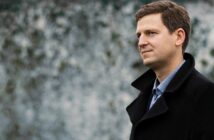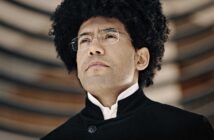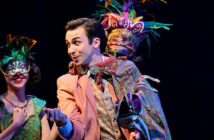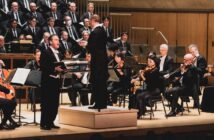by Paul E. Robinson
The Beethoven Ninth Symphony is one of the most overplayed pieces in orchestral literature, but it sells tickets by the bushel and managers seldom go wrong, even when programming it season after season. To call it “overplayed” is not to say that it isn’t a great work or that it doesn’t bring out the best in conductors and orchestras; indeed it is and indeed it does. These facts took me back to Dallas recently to hear Jaap van Zweden and the Dallas Symphony (DSO) engage with the Ninth in the Meyerson Symphony Center.
Van Zweden recorded all the Beethoven symphonies in his native Holland, and recently he recorded the Fifth and the Seventh with the Dallas Symphony. To a certain extent, then, I knew what to expect: intensity, excitement, speed. The quick tempi are by no means arbitrary; Beethoven’s metronome markings require them. That said, conductors of the stature of Otto Klemperer were highly regarded in their time for tempi that were extremely slow – they simply ignored the metronome markings and no-one seemed to care.
That was yesterday. Today we live in a more enlightened time, a time in which period instrument specialists have come to the fore and respect for the written score is more the fashion.
Former Violinist van Zweden a Master of Nuance
From the perspective of the early 21st Century, it might seem obvious that the composer’s metronome markings should be followed. There was a reason, however, why some of the great conductors of the past – not to mention piano soloists and string quartets – looked askance at some of these markings; some of them were surely mistakes. Perhaps Beethoven didn’t understand how to use the newly-invented metronome, or perhaps he was simply too deaf to judge how fast his music could be played. In any case, there is still plenty of room for disagreement over correct tempi for the Beethoven symphonies. Ultimately, the success or failure of a performance depends not so much on choice of tempi but on what the conductors and players can do within those tempi.
In van Zweden’s case what is most remarkable is that he somehow finds time for the most nuanced phrasing even at the fastest tempo. This was particularly evident on this occasion in the slow movement variations. The slower tempi taken by many conductors here to underscore the gravity of the music, often render the move
ment interminable and shapeless. Van Zweden adopts the composer’s metronome markings and this makes the complex figurations the strings must play very difficult. How is it possible to give meaning to this multitude of notes at such tempi? The answer is meticulous rehearsal, with infinite care taken over dynamics and choice of bow stroke. As an ex-string virtuoso, van Zweden has a special talent for achieving the results he’s after.
Two Superb Concertmasters for the Price of One! In this performance, Maestro van Zweden was supported by not one but two master concertmasters at the first desk. Newly-appointed DSO concertmaster Alexander Kerr (photo: right) was on hand and sitting beside him was David Taylor, a longtime assistant concertmaster of the Chicago Symphony. Taylor had been engaged many months ago as a guest concertmaster at the beginning of the search for a successor to Emanuel Borok. Partway through the process, a decision was made to appoint Kerr. That meant that Taylor never got a chance to show what he could do; nevertheless, he honoured his original agreement and came along anyway. It should come as no surprise that the DSO string sound on this night was special.
In this performance, Maestro van Zweden was supported by not one but two master concertmasters at the first desk. Newly-appointed DSO concertmaster Alexander Kerr (photo: right) was on hand and sitting beside him was David Taylor, a longtime assistant concertmaster of the Chicago Symphony. Taylor had been engaged many months ago as a guest concertmaster at the beginning of the search for a successor to Emanuel Borok. Partway through the process, a decision was made to appoint Kerr. That meant that Taylor never got a chance to show what he could do; nevertheless, he honoured his original agreement and came along anyway. It should come as no surprise that the DSO string sound on this night was special.
Incidentally, Alexander Kerr succeeded van Zweden as concertmaster of the Royal Concertgebouw Orchestra. You can see him in action with the RCO playing the solos in Strauss’ Ein Heldenleben with Mariss Jansons conducting, on a DVD issued in 2004 (RCO 04103)
The entire Dallas Symphony played the Beethoven Ninth with commitment and precision. A special mention is due new timpanist, ex-Detroit Symphony principal Brian Jones. He raised the roof in the big moments – his solos in the scherzo, and the dynamic rolls and sharp accents at the recapitulation in the first movement – and blended his sound beautifully with the ensemble when required.
Choral Dynamics and Phrasing Exceptional
The Dallas Symphony Chorus reached an international standard under the late David R. Davidson, and on this occasion was more than adequate under its assistant conductor Melody Gamblin-Bullock. Her name was not included in the original printed programme but by the second night performance – the one I attended – she had made it into the insert. This was an inexcusable oversight. In any case, as of this summer Joshua Habermann (photo:right), a University of Texas graduate with a great breadth of choral conducting experience, will be in charge of the chorus.
What struck me about the choral contribution in this performance were the vast number of major and minor alterations in dynamics and phrasing. These are not found in the printed score but most of them made perfect sense. These were obviously Jaap van Zweden’s ideas and many of them were clearly based on similar passages in the orchestra. It is often said that Beethoven treated voices like instruments. Van Zweden took this characterization literally and made the vocal parts much more expressive and interesting than usual.
Among the soloists there was a last-minute substitution. Soprano Sabina Cvilak fell ill and was replaced by Texas resident Jeanine Thames. Unfortunately, her contribution was simply not up to the overall standard of the performance. On the other hand, bass Luca Pisaroni was excellent, with a strong presence and fine evenness of tone and intonation throughout his wide-ranging solos.
Multi-talented Tao Shines in Shostakovich The concert began with the Concerto No. 1 for Piano, Solo Trumpet and Strings Op. 35 by Shostakovich. The soloist was 15-year-old Chinese-American pianist Conrad Tao (photo: right) , an uncommonly gifted young man who plays both piano and violin and is also a composer. He lives in New York and studies at Juilliard. He charmed the audience with his technique and his ability to tease the playfulness out of the music. Van Zweden “discovered” this young artist at a concert they did together in Singapore and no doubt Tao will become a regular guest with the DSO.
The concert began with the Concerto No. 1 for Piano, Solo Trumpet and Strings Op. 35 by Shostakovich. The soloist was 15-year-old Chinese-American pianist Conrad Tao (photo: right) , an uncommonly gifted young man who plays both piano and violin and is also a composer. He lives in New York and studies at Juilliard. He charmed the audience with his technique and his ability to tease the playfulness out of the music. Van Zweden “discovered” this young artist at a concert they did together in Singapore and no doubt Tao will become a regular guest with the DSO.
The solo trumpet part in the Shostakovich was played with equal virtuosity by principal trumpet of the Dallas Symphony, Ryan Anthony. Anthony tossed off the many fanfares in the piece without appearing to break a sweat and brought a lovely singing quality to the bluesy solo in the slow movement.
For Those Wanting More…
Laurie Shulman writes the uncommonly thorough programme notes for the Dallas Symphony. She also gives many of the DSO’s pre-concert talks. In addition, she is the author of a massive and comprehensive book on the building of the Meyerson Symphony Center. This book is not only an historic document on the construction of one of the world’s great concert halls, but also a first-rate primer on acoustical design. Wearing her acoustical design hat. Laurie was recently invited to the opening of a radically-rebuilt concert hall in Omsk, Siberia. The man responsible for getting the acoustics right in Omsk was Nicholas Edwards, the man largely responsible for ensuring that the Myerson turned out so well. Edwards was also the acoustician for Symphony Hall in Birmingham, England. During her visit to Omsk, Laurie blogged every day for the DSO.
On the subject of concertmasters and former Detroit Symphony musicians, it has just been announced that Detroit Symphony concertmaster Emmanuelle Boisvert will be moving to the Dallas Symphony next season to take up the position of Associate Concertmaster. These latest defections from Detroit underscore how difficult it has been to keep that orchestra going in a tough economy. But Boisvert is a wonderful player and the Dallas Symphony is lucky to have her. This appointment also speaks volumes about the ability of Maestro van Zweden to attract top players to Dallas.
Paul E. Robinson is the author of Herbert von Karajan: the Maestro as Superstar, and Sir Georg Solti: His Life and Music. NEW for friends: The Art of the Conductor podcast, Classical Airs.
Big, Bold & Beautiful: Dallas Symphony and Chorus in Beethoven 9th!
0
Share:














